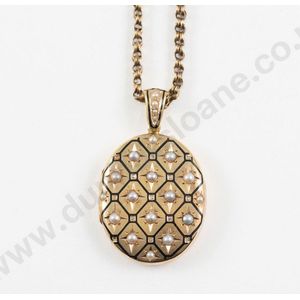Victorian Blue Enamel Diamond Pearl Locket on Gold Chain
Victorian 15ct gold gilt enamel diamond and pearl photo locket, the cover of fine diaper pattern with Royal Blue enamel framing box set rose cut diamonds and gypsy set half pearls on 9ct double trace link neck chain, locket 40 mm height, chain 48 cm long
You must be a subscriber, and be logged in to view price and dealer details.
Subscribe Now to view actual auction price for this item
When you subscribe, you have the option of setting the currency in which to display prices to $Au, $US, $NZ or Stg.
This item has been sold, and the description, image and price are for reference purposes only.
- Victorian Period - The Victorian period of furniture and decorative arts design covers the reign of Queen Victoria from 1837 to 1901. There was not one dominant style of furniture in the Victorian period. Designers used and modified many historical styles such as Gothic, Tudor, Elizabethan, English Rococo, Neoclassical and others, although use of some styles, such as English Rococo and Gothic tended to dominate the furniture manufacture of the period.
The Victorian period was preceded by the Regency and William IV periods, and followed by the Edwardian period, named for Edward VII (1841 ? 1910) who was King of the United Kingdom and the British Dominions and Emperor of India for the brief period from 1901 until his death in 1910. - Rose Cut - A flat based cut for a preious stone, leaving the surface covered with triangular facets, usually 24 in total.
It was introduced in the 15th century and popular during the 16th and 17th centuries.
The rose cut was the most popular form of diamond cut until the discovery of the brilliant cut at the end of the 17th century, after which its use declined. - Diaper Motif - The diaper motif is a repeating geometric pattern in decorative arts that consists of small diamond or lozenge shapes arranged in a grid. The pattern is often used as a background or border on textiles, ceramics, metalwork, and other decorative items. It can be found in a variety of cultures and historical periods, and is often used in formal or ornamental designs. The name "diaper" comes from the pattern's resemblance to the criss-crossed fabric of a baby's diaper.
This item has been included into following indexes:
-
necklaces, gold
- gold and enamel 75
- gold with diamonds 2,054
- necklaces, pearl - pearl, other 565
